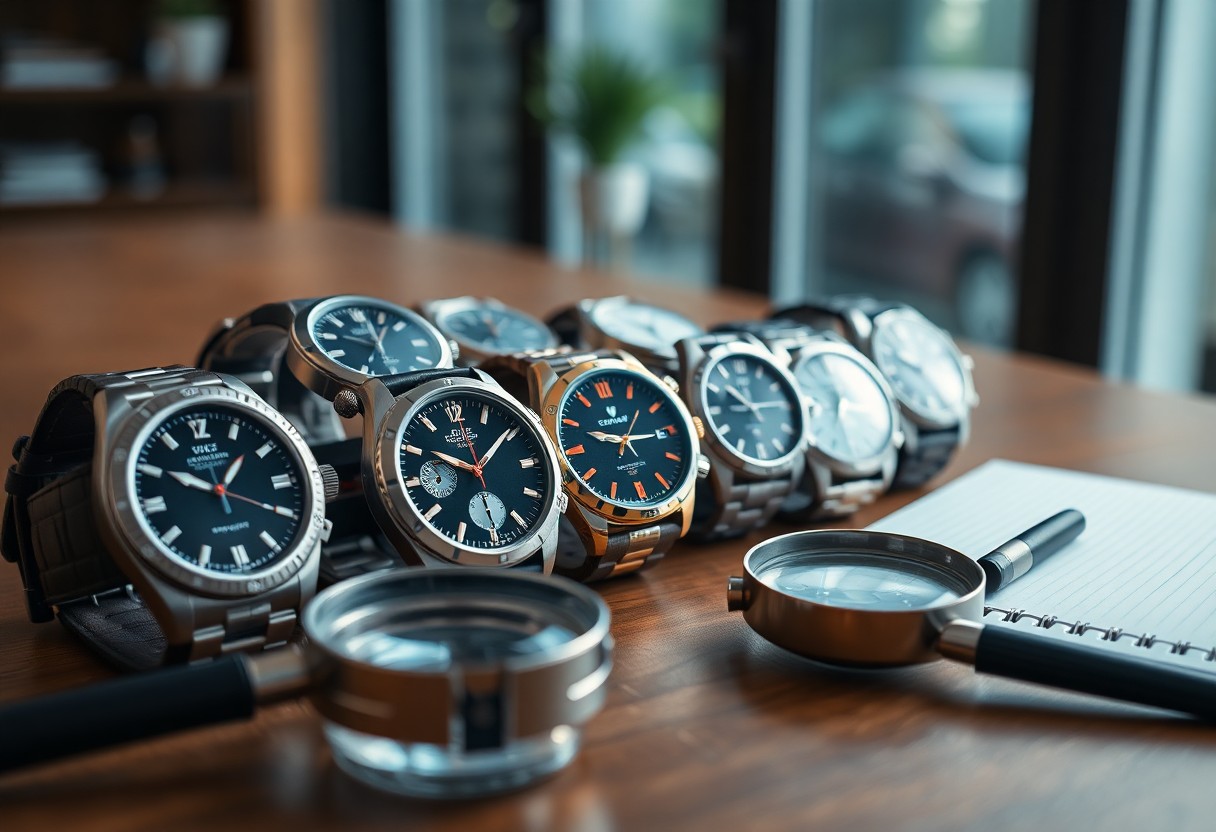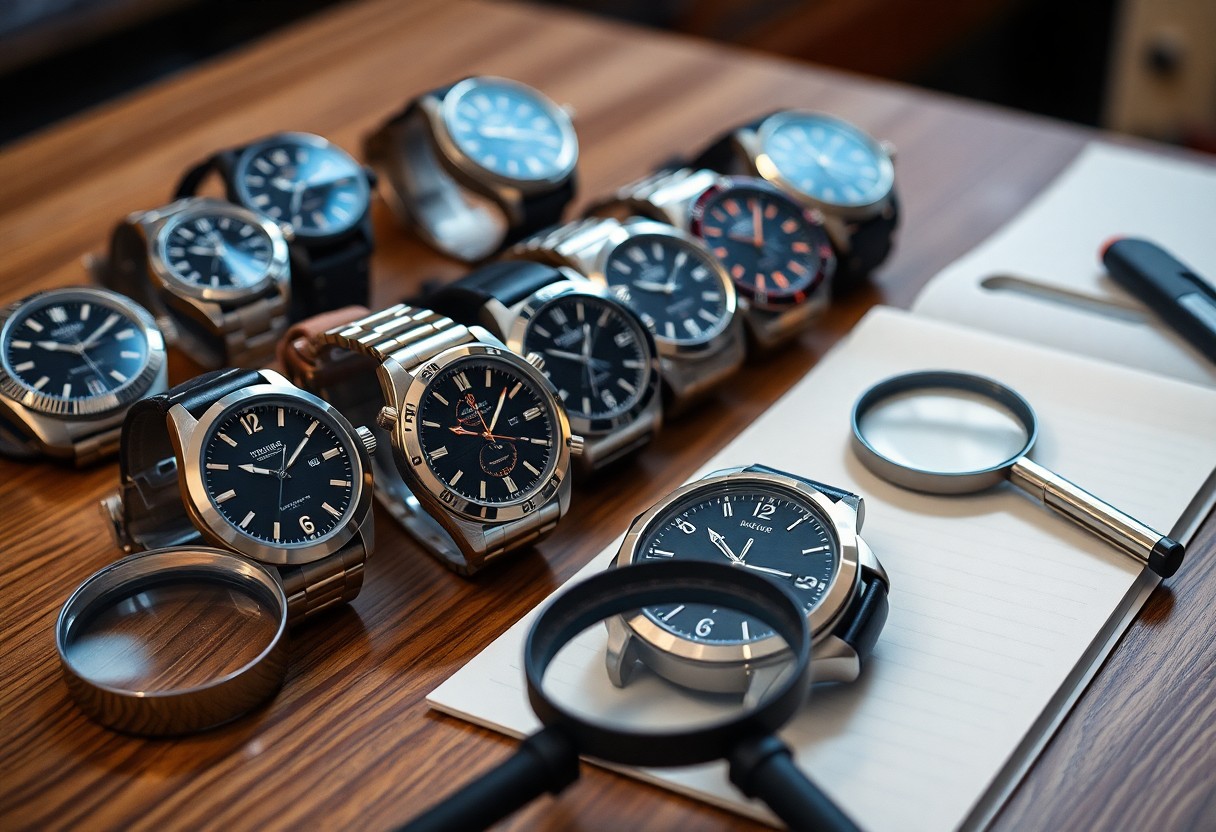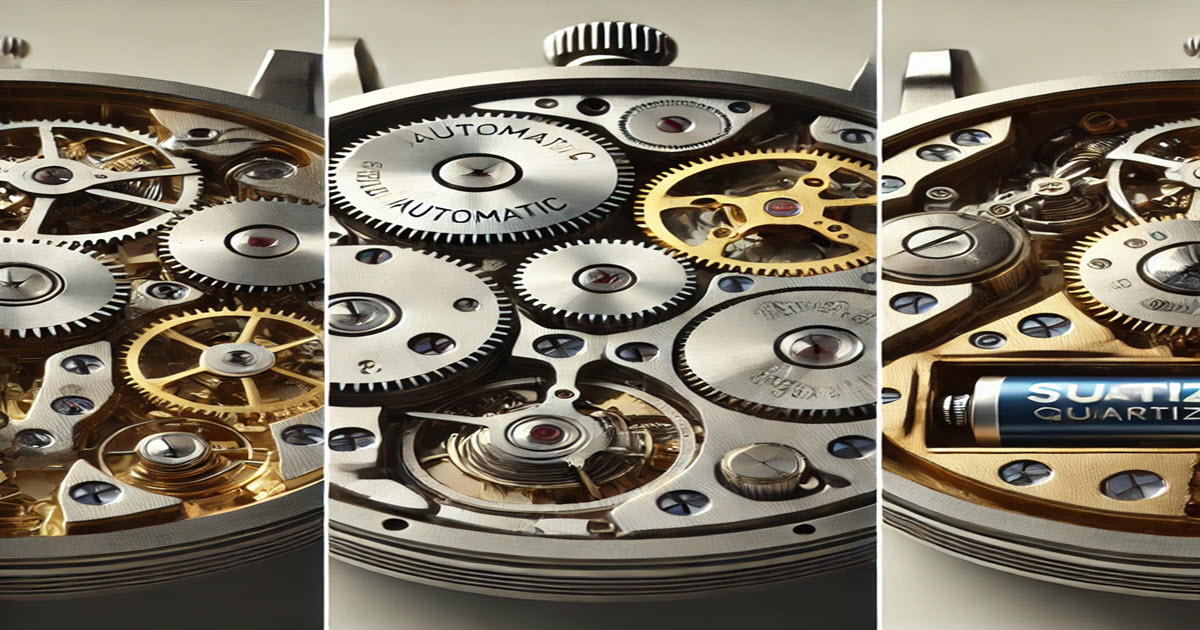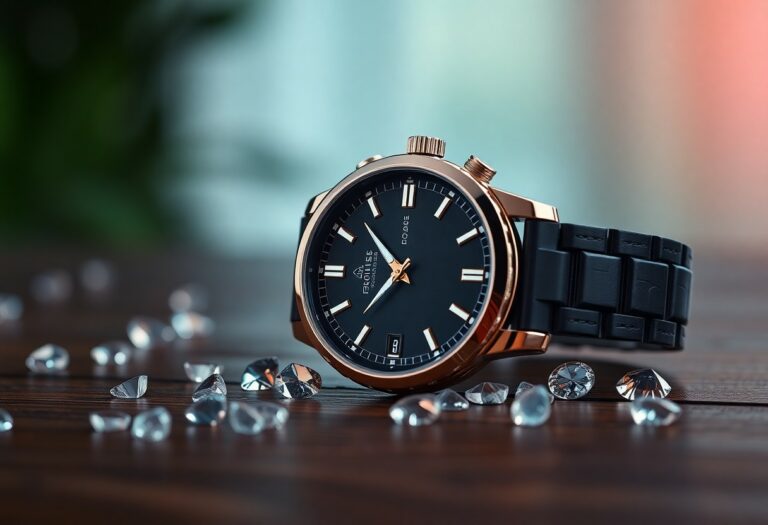Watch collecting opens a fascinating world of craftsmanship and mechanical art, and choosing your first automatic watch can be an exciting yet challenging experience. You’ll need to consider factors like size, movement type, water resistance, and style to find a timepiece that suits your lifestyle and preferences. This guide will help you navigate these options confidently, ensuring your purchase is both practical and enjoyable as you begin your journey into automatic watches.

Key Takeaways:
- Automatic watches are powered by wrist movement and do not require batteries, offering craftsmanship and heritage beyond quartz precision.
- Select a case size that fits your wrist comfortably: typically 38–40mm for smaller wrists, 40–42mm for average, and 42–44mm for larger wrists.
- Reliable beginner movements include Seiko NH35, Miyota 8215, and ETA 2824-2, known for durability, easy servicing, and affordability.
- Choose a water resistance rating based on activity level—at least 100 meters for daily active wear and higher for diving purposes.
- Opt for versatile design elements like neutral dial colors, stainless steel cases, and medium thickness to ensure your watch fits various outfits and occasions.
Understanding Automatic Watches
The world of automatic watches offers more than just timekeeping — it invites you into a realm of mechanical craftsmanship and heritage. Learning how these timepieces function helps you appreciate the intricate engineering that winds itself as you move, eliminating the need for batteries. By understanding the core principles of automatic watches, you gain insight into what makes them distinct and why they’re valued by enthusiasts worldwide.
What Is an Automatic Watch?
Above all, an automatic watch is a mechanical timepiece powered by the natural movement of your wrist. Inside, a rotor swings with your motion, winding the mainspring that stores energy to run the watch. This self-winding mechanism means you never have to replace a battery. Instead, you experience a connection to traditional watchmaking and the fascinating mechanics behind telling time.
Benefits Over Quartz Watches
An automatic watch offers you more than just functionality—it provides a tangible connection to craftsmanship and history. Unlike quartz watches, which rely on batteries and electronics, automatic watches run purely on mechanical energy. This draws you closer to the art of watchmaking, making each glance at your wrist a moment of appreciation for precision engineering and timeless design.
To add depth to this, automatic watches typically feature movements like the Seiko NH35 or ETA 2824, known for durability and craftsmanship, giving you a watch that not only keeps time but tells a story. While quartz watches score high on precision, automatic watches compensate with their longevity, ability to be serviced, and a unique character that Quartz models often lack, offering you a more engaging ownership experience.
Key Factors to Consider
Clearly, when choosing your first automatic watch, several key factors impact both wearability and enjoyment. Consider:
- Case size and comfort for your wrist
- Movement type and reliability
- Water resistance suited to your activities
- Crystal type for durability
- Bracelet or strap material matching your lifestyle
After reviewing these elements, you’ll make a confident choice that fits your daily wear and personal style.
Case Size and Comfort
About case size, it’s important to pick a watch that feels natural on your wrist. Typically, if your wrist measures under 6.5″, aim for 38-40mm; between 6.5″ and 7.5″, 40-42mm works best; and over 7.5″, choose 42-44mm. Comfort should always outweigh current trends, so try different sizes before deciding to ensure your watch sits comfortably throughout the day.
Movement Types
Against the backdrop of numerous options, you’ll find several dependable automatic movements ideal for beginners:
| Movement | Seiko NH35 |
| Power Reserve | ~41 hours |
| Vibration Rate | 21,600 bph |
| Origin | Japan |
| Movement | Miyota 8215 |
Assume that these movements balance durability, ease of maintenance, and cost-effectiveness, making them well-suited for your first automatic watch.
Even with many movements available, the common choices for beginner automatic watches are the Seiko NH35, Miyota 8215, and ETA 2824-2. Each offers a blend of reliability and quality you can count on. Below is a quick summary:
| Movement | Details |
|---|---|
| Seiko NH35 | ~41 hours power reserve, 21,600 bph, Japan |
| Miyota 8215 | ~42 hours power reserve, 21,600 bph, Japan |
| ETA 2824-2 | ~38 hours power reserve, 28,800 bph, Switzerland |
| Pros | Durable, affordable, easy to service |
| Used by | Many reputable brands including Evolution Watches |
Assume that selecting one of these movements guarantees you an enjoyable and reliable first automatic watch experience.

Water Resistance
Unlike regular watches that might suffer damage from moisture, automatic watches come with varying levels of water resistance to protect their intricate mechanical movements. Understanding these ratings helps you match your watch to your daily activities, ensuring your timepiece stays safe whether you’re washing your hands or hitting the pool. Knowing what water resistance means for your watch will help you enjoy it worry-free in different environments.
Levels of Water Resistance
Water resistance ratings indicate how much exposure your watch can handle. For example, 30 meters suits hand washing and light rain, while 50 to 100 meters allows swimming and casual water activities. If you plan on diving or intense water sports, a watch rated 200 meters or more is recommended. Matching your watch’s rating to your lifestyle helps protect the movement and keeps your watch functional longer.
Choosing the Right Rating
After you consider where and how often you’ll wear your watch, pick a water resistance rating that fits your needs. If you’re mostly in an office or casual setting, 30 to 50 meters may be enough. However, if you lead an active lifestyle or want a watch for daily wear that can handle swimming or exposure to water, aim for at least 100 meters. This balance ensures durability without overpaying for features you won’t use.
Plus, watches with higher water resistance often come with stronger construction and better seals, contributing to overall longevity. Choosing a watch with adequate water resistance protects your investment and gives you peace of mind whether you’re caught in the rain or enjoying water-related activities.
Watch Crystals
To protect your watch face, the type of crystal used is crucial for durability and clarity. Watch crystals act as the barrier between your eyes and the dial, influencing both the look and lifespan of your timepiece. Choosing a crystal that balances scratch resistance and affordability helps maintain the watch’s appearance. Understanding these options ensures you pick a watch that will keep its sharp look through daily wear.
Types of Watch Crystals
Against common misunderstandings, watch crystals vary widely in material and toughness. Here’s a comparison to help you decide:
| Crystal Type | Characteristics |
|---|---|
| Sapphire | Highly scratch-resistant, premium durability |
| Mineral | Affordable, moderate scratch resistance |
| Acrylic | Very affordable, prone to scratches, easy to polish |
| Hardlex | Seiko’s proprietary mineral crystal, tough and affordable |
| Glass | Traditional option, less durable than modern alternatives |
- Sapphire offers top-tier scratch resistance.
- Mineral crystals provide a budget-friendly solution.
- Acrylic is better for vintage-inspired watches.
- Hardlex combines toughness with value.
Any choice you make impacts how your watch wears over time and its overall look.
Importance of Sapphire Crystal
With your first automatic watch, sapphire crystal stands out as the best investment for keeping your dial pristine. Its superior scratch resistance means your watch will preserve its clarity and elegance over years of wear. While sapphire crystals generally cost more, their durability pays off by maintaining that fresh appearance without constant repairs or replacements.
It’s this long-lasting protection that makes sapphire the preferred crystal for many quality automatic watches, including those featuring the Seiko NH35 movement. By choosing sapphire, you ensure your watch remains as impressive as the craftsmanship inside, day after day.
Strap and Bracelet Options
For your first automatic watch, selecting the right strap or bracelet is all about balancing style, comfort, and durability. Steel bracelets offer a polished, versatile look that suits everyday wear and formal occasions. Leather straps bring a classic, dressy feel, while rubber or NATO straps cater to sportier, active lifestyles. Think about where and how often you’ll wear your watch to pick the option that fits your daily routine and personal taste.
Comparing Bracelets and Straps
Along with aesthetics, you should consider the benefits and drawbacks of bracelets and straps to find your ideal fit.
| Bracelet | Strap |
|---|---|
| Durable and versatile, often made of 316L stainless steel | Varies: leather offers elegance, rubber/NATO provides sportiness |
| Resistant to wear and sweat, suitable for everyday use | Leather needs more care; rubber is water-friendly and robust |
| Heavier and cooler on the wrist | Lighter and generally more flexible |
Choosing Based on Lifestyle
Straps and bracelets should reflect your lifestyle to maximize comfort and usability. If you’re often in water or exercising, a rubber strap or a steel bracelet with good water resistance (like 100m+) is practical. For office or formal settings, leather or metal enhance your style without sacrificing professionalism. Think about how and where you use your watch most to decide.
This lifestyle approach ensures your watch not only looks great but also performs well day-to-day. For example, a stainless steel bracelet complements versatility and durability, while a leather strap elevates dress occasions. Matching your watch’s strap or bracelet to how you live helps you enjoy it fully, whether at work, leisure, or workouts.
Recommended Beginner Movements
All automatic watches rely on carefully engineered movements, and choosing a reliable one is key for your first timepiece. Movements like the Seiko NH35, Miyota 8215, and ETA 2824-2 are excellent starting points because they combine durability, ease of servicing, and affordability. These movements power countless reputable watches, giving you confidence in your investment. Opting for a tried-and-true movement ensures your watch runs smoothly while you get familiar with mechanical timepieces.
Top Movements for Newcomers
Above all, the Seiko NH35, Miyota 8215, and ETA 2824-2 stand out for beginners. The Seiko NH35 and Miyota 8215, both Japanese-made, offer around 41 to 42 hours of power reserve and a vibration rate of 21,600 beats per hour, making them reliable workhorses. The Swiss ETA 2824-2 operates at a faster 28,800 bph with about 38 hours reserve, delivering a smoother sweep of the seconds hand. These options balance quality and accessibility perfectly for your first automatic watch.
Features to Look For
Any movement you choose should offer reliability, ease of maintenance, and decent power reserve to keep your watch running accurately without frequent winding. A vibration rate around 21,600 to 28,800 beats per hour provides smooth hand movement and precise timekeeping. Additionally, you’ll want a movement backed by widespread availability for parts and servicing, helping you extend your watch’s lifespan with minimal hassle.
A quality automatic movement doesn’t just keep time—it embodies craftsmanship and durability. When you pick one with a solid power reserve of about 40 hours or more, you gain freedom from constant winding. Movements common in reputable brands also benefit from easier access to servicing and parts, meaning your watch stays in prime condition longer. Choosing a movement with a well-known vibration rate ensures smooth hand motion, enhancing both aesthetics and accuracy for your daily wear.
Final Words
Drawing together what you’ve learned, choosing your first automatic watch is an exciting step that blends style, function, and craftsmanship. By focusing on comfort, reliable movement, water resistance, and versatile design, you ensure your timepiece suits both your lifestyle and personal taste. With thoughtful selection, your automatic watch becomes more than a tool—it’s an expression of your connection to time and tradition. Take your time exploring options, and you’ll find a watch that not only tells time but also tells your story.
Our Recommendation for First-Time Buyers
Explore the Evolution Genesis Series — combining bold design with the trusted Seiko NH35 movement, scratch-resistant sapphire crystal, and water resistance up to 100 meters.
It’s built for everyday use, but looks sharp enough for any occasion.
FAQ
Q: What is the main difference between an automatic watch and a quartz watch?
A: An automatic watch is powered by the movement of your wrist through a mechanical rotor that winds the mainspring, while a quartz watch runs on a battery and uses electronic components for timekeeping. Automatic watches offer a connection to traditional watchmaking craftsmanship, whereas quartz watches are known for their high precision and low maintenance.
Q: How do I choose the right case size for my wrist?
A: Case size selection depends on your wrist circumference. For wrists under 6.5 inches, watches sized 38–40mm generally feel comfortable and balanced. For wrists between 6.5 and 7.5 inches, 40–42mm works well. Larger wrists over 7.5 inches suit 42–44mm watches. Trying different sizes will help you find the most natural fit.
Q: What are some recommended automatic movements for beginners?
A: Popular beginner-friendly movements include the Seiko NH35, Miyota 8215, and ETA 2824-2. These movements are recognized for their durability, ease of servicing, and affordable price points. They offer reliable performance and are commonly found in entry-level automatic watches from reputable brands.
Q: Why is water resistance important, and what level should I look for?
A: Water resistance protects your watch from damage due to moisture exposure. For everyday wear, especially if you’re active or swim frequently, aim for at least a 100-meter water resistance rating. Lower ratings like 30m or 50m are suitable for light water exposure such as hand washing or rain but not for swimming or diving.
Q: What are the advantages of sapphire crystal compared to mineral crystal?
A: Sapphire crystal is highly scratch-resistant and offers a premium, clear appearance, helping your watch maintain its sharp look over time. Mineral crystal is more affordable but less durable and prone to scratches. Choosing sapphire crystal adds longevity and a higher-end feel to your timepiece.
Q: Should I choose a bracelet or a strap for my first automatic watch?
A: The choice depends on your lifestyle and style preference. Stainless steel bracelets are durable, versatile, and suitable for both casual and formal occasions. Leather straps provide a more classic, dressy look, while rubber or NATO straps are sporty and great for active use. Many first-time buyers favor the polished look and strength of stainless steel bracelets.
Q: How can I ensure my first automatic watch suits my everyday wear?
A: Opt for a versatile design with neutral dial colors such as black, blue, or white combined with a stainless steel case. Medium case thickness helps avoid a bulky appearance, making the watch comfortable and suitable for various outfits. This approach ensures your watch complements both casual and formal attire seamlessly.




